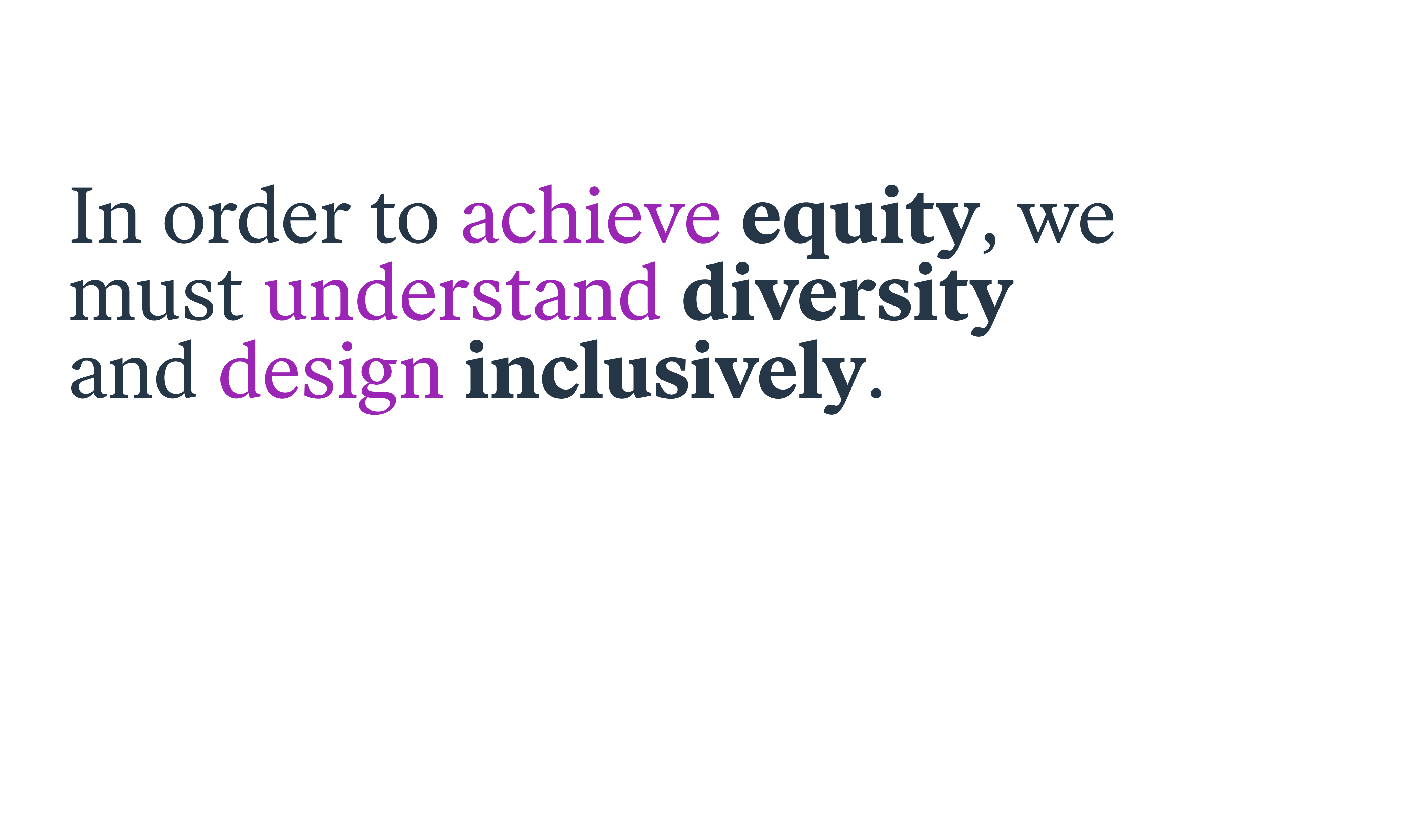Recognizing World Interaction Design Day: Exploring “Product Inclusion”
 Morgan Keys
5 min read
Morgan Keys
5 min read
Today is World Interaction Design Day, IxDA's annual event meant to encourage the global design community to show “how interaction design improves the human condition.” We're recognizing this year’s theme—Ethics, Equity, + Responsibility—by sharing 12 dimensions of diversity that we're exploring here at DesignMap to deepen our product inclusivity practices.
Today is World Interaction Design Day, IxDA's annual event meant to encourage the global design community to show “how interaction design improves the human condition.” This year’s theme is: Ethics, Equity, + Responsibility.
At DesignMap, we are committed—both as individuals and on behalf of our clients—to continue educating ourselves and understanding the many complex, albeit incredibly important nuances of creating products that consider the needs of all users.
Annie Jean-Baptiste, Head of Product Inclusion & Equity at Google and author of Building for Everyone, offers a great reflection on what happens when product inclusivity is overlooked:
“When we don’t fit in or when products or services do not feel as though they were built for us, we feel excluded, frustrated, disappointed, or even upset. When a product or service seems to be designed for everyone but us, we can feel as though we were ignored or disregarded by those involved in the product design process.
Our feelings can range from mere annoyance (‘Whatever, I didn’t want to use this thing anyway’) to deep alienation or hurt (‘I feel like this does not represent me or my community and what this represents is threatening’).”
So, how can product teams, and designers specifically, rethink how they approach inclusive products? As diversity and inclusion champion Joe Gerstandt says: “If you do not intentionally, deliberately, and proactively include, you will unintentionally exclude.”
Unfortunately, there are many examples of user experiences that are not just alienating to users, but psychologically or materially harmful. As product creators, we have an obligation to not only serve our users, but prevent harm.
And if that moral imperative is not compelling enough, consider how the public judges products that exclude or do harm. It does not bode well for users or the companies who serve them to ignore the many diverse needs of their users.
Defining DE&I in product

Last year, we had the opportunity to help a client explore “Product Inclusion”—that is, the process and philosophy behind designing more inclusive products. We were asked to interview experts within the client company, as well as research industry best practices, to understand how Product Inclusion could be adapted to the unique, high pressure demands of “zero-to-one” product development—that is, going from concept to initial product offering in a start-up-like environment.
We first sought to define key ideas related to inclusion. You may be familiar with the terms “diversity, equity, and inclusion”—they are often shortened to “DEI” and used generally to refer to groups or initiatives that aim to dismantle systems of discrimination and inequality (or “inequity”) in our work and society. Part of our work was to explore what each of these terms meant.
Let’s start with diversity. Diversity recognizes the fact that human beings show remarkable variation in their physical, psychological, and social characteristics. They also come from many backgrounds and experiences and may have different abilities, different needs, or different opportunities available to them. How people perceive, interact with, and expect products to work is significantly impacted by their diverse experiences.
In product, inclusion is the principle of including people of diverse identities and needs in your design process to ensure their needs are considered.
In our research into “product inclusion,” we discovered that “equity” can actually be thought of as a step beyond inclusion. That is, just because you include people in your development process, it doesn’t always mean that they will get the same results. “Equity” is the state when a user’s characteristics, background, or identity no longer affect their ability to derive value or enjoyment from the product. It is a goal achieved not only by including diverse backgrounds in your process, but also by anticipating their disadvantages and measuring real-world outcomes. Diverse users need to be included at every stage of product development, including measuring impact for all users after product launch (not just during the research phase).

Understanding diversity to shape more inclusive design
At DesignMap, we’re undertaking a multiphase, internal initiative to deepen our tools and methods for creating more inclusive products.
It’s one thing to say you should include a wide variety of people in your user research and solutions, but what exactly does that mean? Who do you need to include? Do you need to include everyone all of the time? And, how do you anticipate which perspectives will be most important?
To create products with more equitable outcome, we believe the answer to these multifaceted questions require a multifaceted approach:
- Gaining familiarity with various dimensions of inclusion and accessibility.
- Determining which of the dimensions you need to focus on by either supporting those differences as part of ideation towards solutions and/or for further learning through research, based on existing knowledge of users.
- Recognizing who you are including as your prospective target users, and who you are excluding (as well as exploring the reasons for why).
- Fostering discussion and reflection to be more intentional about who you are creating products for and the outcomes of these product experiences at every stage of product creation.

For this post, I’ll be focusing on the first part of this approach: gaining familiarity with various dimensions of inclusion and accessibility.
At DesignMap, we’ve started a series of research projects into different “dimensions” of diversity and—in the spirit of World Interaction Day’s theme of Ethics, Equity, + Responsibility—we want to share the 12 dimensions we’re focused on and how they might impact the product experience.
These have quite a bit of overlap with the dimensions outlined in Annie Jean-Baptiste’s Building for Everyone, with some slight variations:
- Ability: The user’s physical capabilities such as eyesight, hearing, and motor function. This is most closely related to the practice of “accessibility.” Can people with physical differences and/or impairments use your product?
- Age: The physical, cognitive, and even cultural or value changes that occur through life experience. How do you design differently for children, teens, or elderly adults?
- Neurodiversity: User’s cognitive or neurological differences; related to conditions such as ADHD or Autism. How might your product accommodate users with different neurological types?
- Economics: A user’s economic reality. Is your product expensive to maintain? How will your product work in regions with less infrastructure or access to resources?
- Socio-economics: How economics have shaped the user’s experiences, knowledge, values, and more. What does your user value most: quantity, quality, or presentation? Do your users have access to the same educational resources?
- Risk-Level: Users with unique situations or contexts that make them particularly vulnerable. This might include users who are political dissidents, journalists, or domestic abuse victims. Does your product provide privacy or safeguards that protect your users from exploitation or surveillance?
- Language: Does your product support other languages? Do your users read right-to-left as opposed to left-to-right reading? Do they use special characters?
- Culture: Differences in values, beliefs, traditions, mental models, and more. Will users of other cultures understand your figure of speech? Do they interpret color significance in the same way you do?
- Religion: Does your product take into consideration different religious backgrounds? Does your product provide enough information to support users religious practices? Does your shopping app have dietary information? Does your scheduling app account for religious holidays?
- Sexual Orientation: The spectrum of preferences in sexual/romantic partners. Is there photography or illustration that depict couples of all kinds?
- Gender: Gender dynamics and the spectrum of gender expression. Does your product require the user to identify their gender and does it support non-binary options or the ability to decline?
- Ethnicity/Race: A user’s racial or ethnic background. Does your photography or illustration depict a wide variety of ethnic/racial background? Is your computer vision algorithm trained on different skin color and hair types? Does your online community/market place have safeguards against discrimination or harassment?
Of course, the above is not a definitive list of diversity dimensions, but we hope this structure will allow us to learn and expand our understanding of inclusivity practices with greater intention. It’s also important to note that intersectionality exists—meaning one individual could represent several of the above dimensions and that in itself requires further consideration.
Deepening our Inclusion & Equity practice
Inclusion and accessibility have always been a priority at DesignMap but, as with any nuanced and complex practice, we want to continue to learn, grow, and evolve our understanding of designing products for everyone.
Over the next year, we will continue to deepen our expertise in these areas and continue to develop tools and approaches to put our learnings into practice. We hope to share new insights and methods from this process to help further learnings, not just for our team and clients, but for any product or design professional who believes it is their responsibility to create products that meet the needs of the many (and not just the few).

